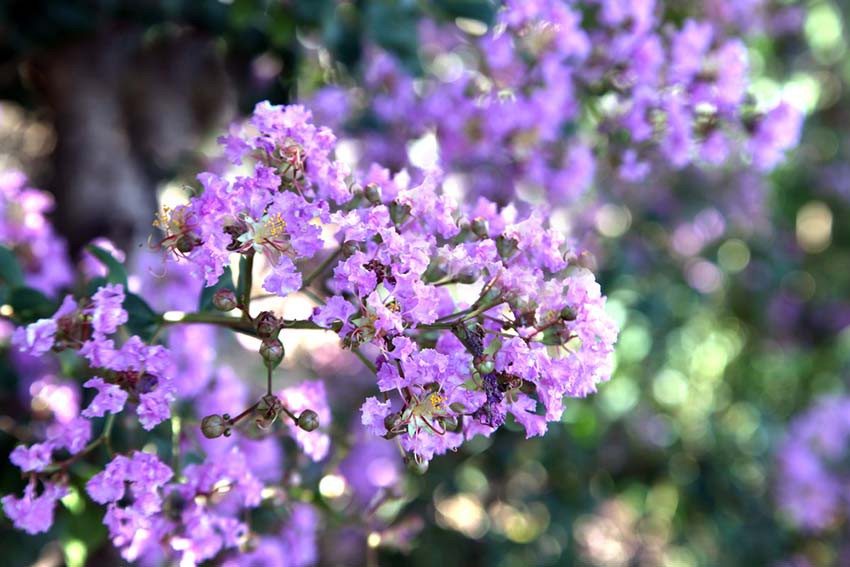Crepe, Murder and Neglect

Frangipani, hibiscus and bougainvillea are rewarded by loyal followings in dedicated horticultural societies.
Spring flowers are almost forgotten by February and March. The audacity of frangipani, hibiscus, bougainvillea and crepe myrtle to delight in our relentless summers seems impossible during a heat wave. Yet once accorded a reasonable opportunity, and some investment in establishment, their spectacular floral display and heroism secure their place. Frangipani, hibiscus and bougainvillea are rewarded by loyal followings in dedicated horticultural societies. Crepe myrtles don’t seem to have won quite the same commitment. Even in the US, the home of modern hybrid crepe myrtles, the American Crape Myrtle Society seems to have run its course. Crepe myrtles have been cultivated in China since at least the Tang dynasty that spanned the seventh to 10th centuries and appear in Chinese paintings from the 16th century. Common names for Chinese crepe myrtles include 100 Days Red (reflecting their long flowering period), Monkey Slip (identifying the smooth showy bark) and Itch Tree (reflecting the quivering of the whole tree when the trunk is touched). Crepe myrtles arrived in Europe much later – at Kew Gardens in 1759 (via the Duke of Northumberland across the Thames at Syon House). British summers rarely allowed crepe myrtles to flower and needless to say there was limited enthusiasm for a slow growing tree that flowered erratically. William Bean’s marvellous Trees and shrubs of the British Isles drolly observes of a specimen at Borde Hill in Sussex. “It flowered freely in 1911. Sir Edmund Loder told me that a plant produced flowers the same year at Leonardslee which had not bloomed for twenty years previously. The plant at Borde Hill next flowered in 1933. Its autumn colouring is invariably good and its leaves are retained for several days after assuming their rich tints. This plant flowered again after the hot summer of 1959; in 1969, perhaps owing to the late spring, flower-buds were set but failed to open.” So, in 58 years to 1969 there are three fine flowerings and one almost but not quite – hardly likely to secure a place in a garden as a choice flowering tree! However, modern hybrids and global warming are fast changing this reckoning. Crepe myrtles began cultivation in the United States in the late eighteenth century. Louis XVI’s Royal Botanist André Michaux arrived in the US in 1785 and is often credited with first propagating crepe myrtles at his nursery and botanic garden in Charleston, South Carolina. In contrast to Britain, crepe myrtles prospered here. Legendary breeder Donald Egolf records specimens in the South with girths exceeding two metres, heights and crown spreads of over 15 metres. In Australia, crepe myrtles appear in Sir William Macarthur’s first nursery catalogue from Camden Park by 1820. Lagerstroemia indica is the common crepe myrtle species, and despite the specific epithet is native to China. While best known in cultivation, famed plant hunter E.O. Wilson observed wild crepe myrtles in open grassy places and on cliffs at low altitudes from central to western China. Donald Egolf began hybridising L. indica with the Japanese L. fauriei (L. subcostata var fauriei) in 1956, and his work with the US National Arboretum in Washington changed the garden landscape from the 1960s. His hybrids, named for Native American tribes, extended crepe myrtle’s sizes colour range and disease resistance – and still comprise a significant part of the market. The genus includes around 60 species with one, L. archeriana, a showy tree native to northern Australia. Carl Linnaeus named Lagerstroemia for Magnus von Lagerström, a merchant from the Swedish East India Company who’d provided Linnaeus with specimens from China (along with a rhinoceros horn cup). Perhaps recognition for the redoubtable German botanist Georg Rumphius might have been appropriate. Rumphius was employed as a koopman (and more particularly as a spice merchant) for the Dutch East Indies Trading Company (VOC) based on Ambon in the Maluku Islands (then the Moluccan Islands). The publication of his six volume flora was an astonishing achievement. Rumphius went blind from glaucoma in 1670 aged 43, his wife and one of his daughters died in an earthquake in 1674 and his illustrations were lost in a fire in 1687. The copy of manuscript sent to Europe for publication was destroyed when the vessel carrying the flora was sunk by the French off the coast of Brittany in 1690. Astonishingly a copy made and retained in Batavia allowed the flora to finally reach Holland in 1696. In the context of the lucrative spice trade the commercial value of the Herbarium Amboinense was seen to be sensitive – resulting in the VOC delaying publication until 1741 (and crepe myrtle, under the native name of tsjinkin even later) – half a century after Rumphius’s death. Crepe myrtle flowers on new growth each season, so you can prune plants any time during the late winter or early spring before growth begins without losing flower buds. When pruning, remember that new growth will emerge around 10 centimetres from the cut. Hacking back large limbs, a peculiar but common practice, sees new growth emerge in curious pom-poms. In the US, this type of pruning is rightfully referred to as `crape murder’. The specimens planted by Noel Lothian and Alan Correy adjacent to the Western Wild Garden in Adelaide Botanic Gardens have largely been neglected – and are all the better for it! Crepe (French & Australian) or crape myrtle or crapemyrtle (both American) – up to you. Stephen Forbes, Director, Botanic Gardens of Adelaide @StephenJForbes